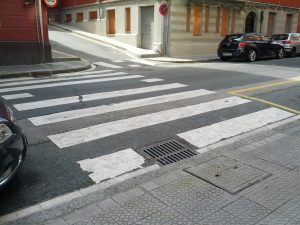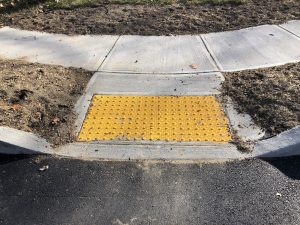Universal Design for Learning
Introduction to the UDL Framework
The “Curb Cut Effect” and Universal Design
Consider the two images below:


The sidewalk in the photo on the right slopes downward so that the concrete at the end of sidewalk runs flush with the pavement of the road. In the photo on the left, however, the curb does not have a similar ramp “cut” into it and presents about a six-inch step up from the road to the sidewalk.
Which end of the sidewalk strikes you as atypical – the one with the ramp, or the one without?
In what circumstances would the curb across the street pose a barrier to your ability to get where you’re going?
It’s likely that you find the sidewalk on the left – the one without a ramp cut into it – atypical. In the U.S., the “curb cut” has become not only a familiar but expected feature of our built environment. This is remarkable given its origin as a form of assistive technology meant specifically to make sidewalks accessible to people using wheelchairs. Disabled advocates had to fight to make curb cuts a universal feature in urban design, pointing out time and again the many ways in which roads, walkways, and buildings were designed and constructed by the able-bodied for the able-bodied – literally barring disabled people from full participation in public life. As with so many disruptions to the status quo for the benefit of a marginalized group, the curb cut was met with resistance.
That is, until the curb cut effect was fully recognized by urban planners, architects, and others. As it turns out, many more people in addition to people with wheelchairs benefit from the ramp between road and sidewalk: parents with strollers; workers pushing carts; cyclists, skateboarders, and runners. The curb cut and the “curb cut effect” present a powerful example of how disability activism and universal design in our built environment benefit everyone.
Universal Design is the design of buildings, spaces, and products with the explicit intention of making them accessible to all people, to the greatest extent possible. In other words, Universal Design is a framework for approaching design in ways that anticipate and value diverse ways of being in the world.
References & Further Reading
- Essay by Angela Glover Blackwell in the Stanford Social Innovation Review (link opens in new tab): “The Curb-Cut EffectLinks to an external site..”
- Short essay by Disability Science Review at Medium.com (link opens in new tab): “The Curb Cut Effect: How Making Public Spaces Accessible to People With Disabilities Helps EveryoneLinks to an external site..”

